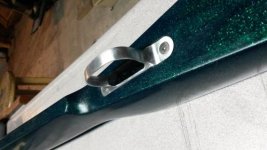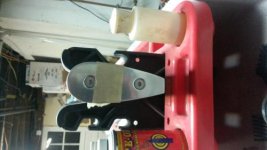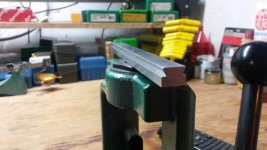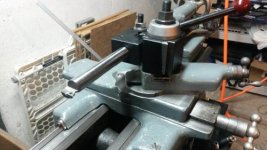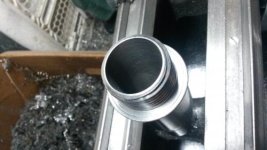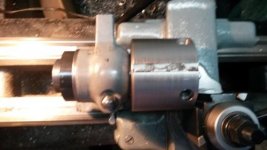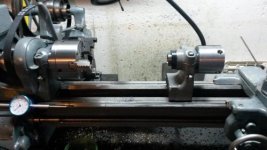Wanted to share some photos of the bits and pieces of the bench gun I am building my father. It will be a 220 Beggs when it gets done. Just waiting on the action amd we will get started with the barrel fitting. It has been a lot of fun and a great learning experience trying to get the fit just right. I ended up making aluminum pillars for the screws in the butt plate and trigger guard. Still getting a hang of the mill though. Turned the handle on the y axis the wrong way and had to blend in the radius going from the screw hole to the rounded portion of the trigger guard. Came out ok though.
You are using an out of date browser. It may not display this or other websites correctly.
You should upgrade or use an alternative browser.
You should upgrade or use an alternative browser.
pics of my first benchrest build in progress
- Thread starter savet06
- Start date
Some pics of the scope base and boring bar I made. I have since made a better fitting scope base with a better finish. The boring bar was used to open up the spindle I bought on ebay out to 1.220" so that I can try my hand at the through the headstock method of chambering. I turned down the back plate of an old chuck I had and pressed/epoxied it into a piece of scrap I found at the local steel yard. The wall thickness on the scrap is probably overkill but it fit my needs perfectly otherwise and the price was right. I have since gone to 1/2-20 screws and fashioned some brass tips for them. I borrowed the idea from coyotechet who has been guiding me through the process of fitting the dummy headstock to the bed of my lathe.
I am close to the final fitting and will post some pics when I get done. I will be threading the o.d. of the outboard portion of the spindle I bored for a locking collar and thrust bearing to hold the spindle in place while the barrel is turning. Heck of a lot of fun.
Mike
I am close to the final fitting and will post some pics when I get done. I will be threading the o.d. of the outboard portion of the spindle I bored for a locking collar and thrust bearing to hold the spindle in place while the barrel is turning. Heck of a lot of fun.
Mike
Attachments
Last edited:
Dusty Stevens
Hollow Point Dispenser
Keep on posting with progress
I realize that I forgot to mention that I made the trigger guard and butt plate from scratch. I had it in my mind that I mentioned it in the post, and I can see why it might not have been as impressive to see the pics of a trigger guard and butt plate on a bench gun!
I am sure that there are many on here who do the same, but I am a novice and still learning the ropes.
I will post more when the second headstock and spider/cats head is done. And then, certainly, when the rifle is put together and has shot its first groups.
Mike
I am sure that there are many on here who do the same, but I am a novice and still learning the ropes.
I will post more when the second headstock and spider/cats head is done. And then, certainly, when the rifle is put together and has shot its first groups.
Mike
Boyd Allen
Active member
What lathe do you have? I find the part about boring out the spindle especially interesting. There was a fellow that used to shoot at Visalia that told me that he had done that to his lathe, for the same reason. I think that his was a 9" south bend, although it has been a while, and I am not sure about that.
Boyd,
That is exactly what I have a 9" south bend. I have had my eye on a PM 1340gt for a while but just cant justify the outlay at this time. The south bend came out of a machinists garage and wasnt in woking order. I stripped it down, cleaned it up and added some modern parts. It does everything I need it to but I wanted to try my hand at this method and for $100 for the headstock and spindle off ebay and my time I figured I couldnt lose!
That is exactly what I have a 9" south bend. I have had my eye on a PM 1340gt for a while but just cant justify the outlay at this time. The south bend came out of a machinists garage and wasnt in woking order. I stripped it down, cleaned it up and added some modern parts. It does everything I need it to but I wanted to try my hand at this method and for $100 for the headstock and spindle off ebay and my time I figured I couldnt lose!
Boyd Allen
Active member
So, to be clear, you bored out the spindle of the lathe while in place, with a stout boring bar? The reason that I ask is that there are a fair number of 9" SBs that come up for sale, that would be quite suitable for barreling, if the holes in their headstocks were larger.
That is a great question, Boyd.
The way I did it was to set up the parted end of the spindle in a four jaw and steady rest on the bearing surface, and indicate the bearing portion of the spindle to under .0005 in two places (Chet wanted me to get to .0001 but I just couldn't get there). My line of thinking was that I want the bore to be as concentric with that bearing portion as possible. The parted spindle hung out a good 5" from the four jaw and without the steady I would have never gotten anywhere. I would check my run-out on the bearing portion of the spindle after every 2-3 passes of the boring bar and adjust as needed. As long as I was fairly conservative with maybe .010 d.o.c. (0.020 per pass) I could maintain concentricity. As far as the boring bar goes, stout is a subjective term to use for these little machines, but I made it as large as I could for the hole with which I was working...around .750 o.d. on the boring bar if memory serves.
I was expecting the spindle to be hardened, but I must have gotten an earlier model as I was able to part and bore the spindle with relative ease using a portable bandsaw and hss tooling. I wasn't able to part the spindle in the lathe, but my little grizzly bandsaw made short work of it. The headstock is cast iron and was also parted easily with the bandsaw.
Mike
The way I did it was to set up the parted end of the spindle in a four jaw and steady rest on the bearing surface, and indicate the bearing portion of the spindle to under .0005 in two places (Chet wanted me to get to .0001 but I just couldn't get there). My line of thinking was that I want the bore to be as concentric with that bearing portion as possible. The parted spindle hung out a good 5" from the four jaw and without the steady I would have never gotten anywhere. I would check my run-out on the bearing portion of the spindle after every 2-3 passes of the boring bar and adjust as needed. As long as I was fairly conservative with maybe .010 d.o.c. (0.020 per pass) I could maintain concentricity. As far as the boring bar goes, stout is a subjective term to use for these little machines, but I made it as large as I could for the hole with which I was working...around .750 o.d. on the boring bar if memory serves.
I was expecting the spindle to be hardened, but I must have gotten an earlier model as I was able to part and bore the spindle with relative ease using a portable bandsaw and hss tooling. I wasn't able to part the spindle in the lathe, but my little grizzly bandsaw made short work of it. The headstock is cast iron and was also parted easily with the bandsaw.
Mike
Boyd Allen
Active member
It seems that I misunderstood you. You built a half headstock (cut a second headstock in half) to sit between the headstock and tailstock, so that you could hold and drive a barrel with the four jaw on the regular headstock, and dial the chamber end in using the spider that you made from a backing plate that is attached to the shortened spindle and half headstock out on the ways. Is that correct? How did you retain the shortened spindle in the single bearing of the split headstock axially. The fellow that I referred to in my earlier post had bored out his main spindle in place, which is what I thought that you were talking about. I would think that your lathe would have to have a relatively long bed to use the setup that I think that you built for barrels of normal length.
MilGunsmith
Member
I have a set of plans from Speedy for a similar setup using a ball bearing and all fabricated parts.
Boyd,
I have threaded the outboard portion of the parted spindle (and yes your understanding of the parted headstock and spider is right on) and have made a threaded locking collar that will press up against a thrust bearing (washer, needle bearing, and washer combo) in order to hold the spindle in axial alignment.
I will take some pics when I get home tonight so it will make more sense. What is often clear in my kind does not always come out in writing at least when it comes to this stuff...in my day job I am much more eloquent with my explanations!
Mike
I have threaded the outboard portion of the parted spindle (and yes your understanding of the parted headstock and spider is right on) and have made a threaded locking collar that will press up against a thrust bearing (washer, needle bearing, and washer combo) in order to hold the spindle in axial alignment.
I will take some pics when I get home tonight so it will make more sense. What is often clear in my kind does not always come out in writing at least when it comes to this stuff...in my day job I am much more eloquent with my explanations!
Mike
Dusty Stevens
Hollow Point Dispenser
I have a set of plans from Speedy for a similar setup using a ball bearing and all fabricated parts.
Can you post this or send it to me?
MilGunsmith,Can you post this or send it to me?
I'd be interested in having a copy of that too, por favor.
Justin
MilGunsmith
Member
I have it on work computer as a PDF. Will try posting it tommorow
Dusty Stevens
Hollow Point Dispenser
Thank you sir
Here are some pics for those interested. what you see is the outboard portion of the parted spindle being threaded and a locking collar that i also threaded pressed up against the thrust bearing assy.I still need to refine the fit of the thrust bearing but you get the general idea. I am also needing to trim some of the fat off of the spider but am in no rush for that.
Attachments
MilGunsmith
Member
coyotechet
Chet
9" South bend
Here is a couple of pictures of the reverse head stock that Mike (savet06) is building. I built this one around 15 or more years ago and chambered quite a few match winning barrels on it. The reverse head stock will only do barrels up to 1.220 diameter. I now do most all barrel work on my Heavy Ten. But still like working with the 9" and reverse head stock.
P.S. Mike Looks like you are coming along pretty good keep up with the pictures.
Chet
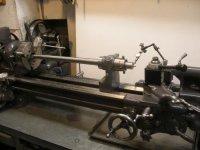

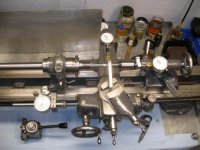
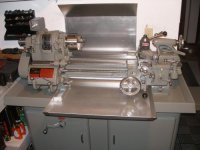
Here is a couple of pictures of the reverse head stock that Mike (savet06) is building. I built this one around 15 or more years ago and chambered quite a few match winning barrels on it. The reverse head stock will only do barrels up to 1.220 diameter. I now do most all barrel work on my Heavy Ten. But still like working with the 9" and reverse head stock.
P.S. Mike Looks like you are coming along pretty good keep up with the pictures.
Chet




Boyd Allen
Active member
Chet,
Thanks for the pictures. Wow. Obviously your equipment is in peak condition, and your shop is an example to us all.
Boyd
Thanks for the pictures. Wow. Obviously your equipment is in peak condition, and your shop is an example to us all.
Boyd


